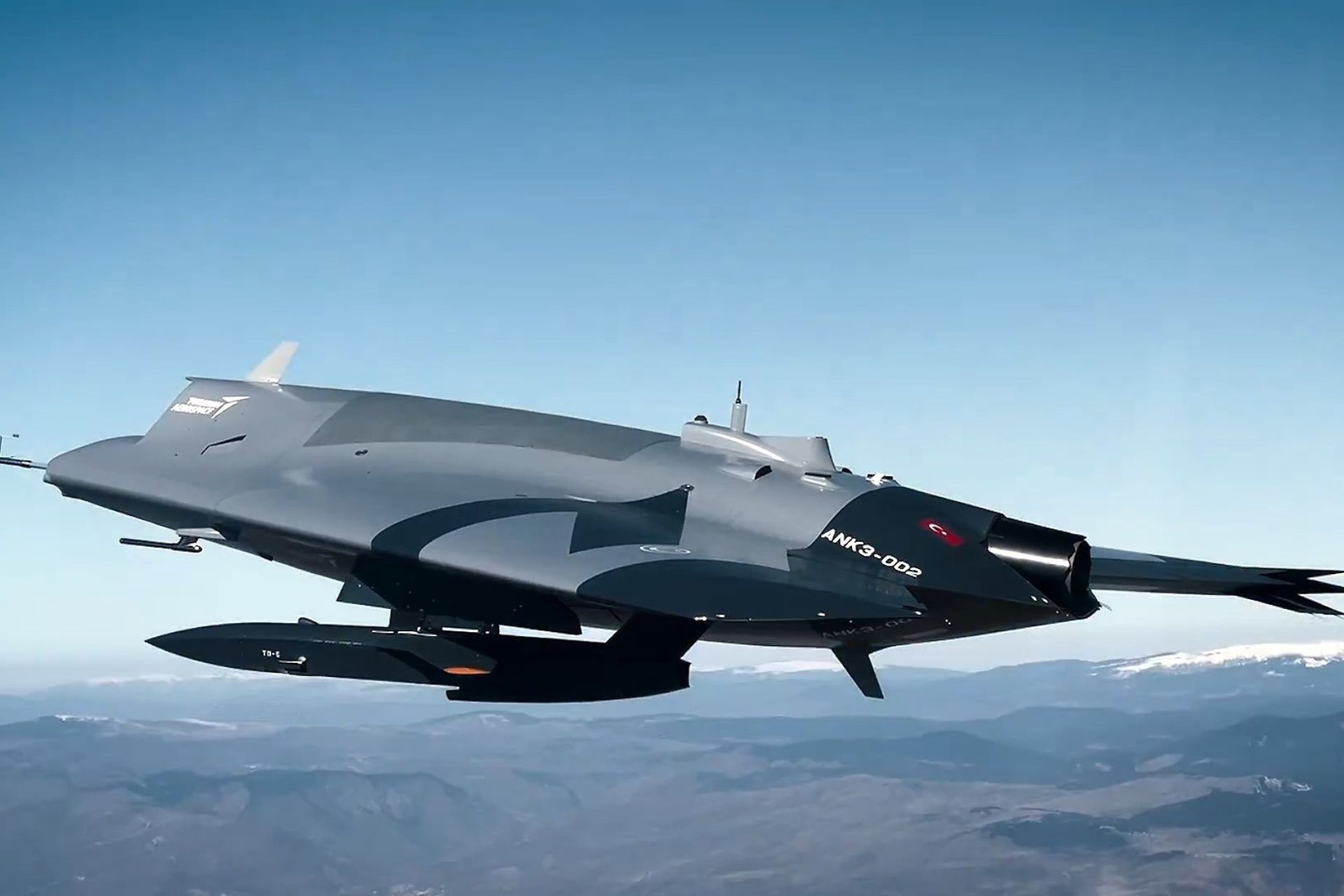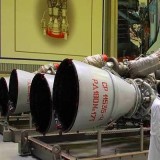Türkiye Validates OKU Concept as ANKA III UCAV Successfully Launches Super Şimşek Drone Mid-Flight

{loadposition bannertop}
{loadposition sidebarpub}
On April 8, 2025, Turkish Aerospace Industries (TUSAŞ) achieved a new milestone in the development of its autonomous air combat ecosystem by successfully launching the high-speed Super Şimşek drone mid-flight from its stealth UCAV ANKA III. Conducted at an altitude of 10,130 feet and a true airspeed of 150 knots, the test marks a significant step forward in Türkiye’s Otonom Kol Uçucusu (OKU – Autonomous Wingman) program, a strategic initiative aimed at integrating unmanned platforms with manned aircraft within a networked warfare environment.
Follow Army Recognition on Google News at this link
The OKU program is Türkiye’s national response to the globally emerging Loyal Wingman concept, which involves deploying semi-autonomous drones in support of piloted combat aircraft during high-risk missions (Picture source: TUSAS )
Unveiled in 2023 and having completed its maiden flight in December of the same year, the ANKA III represents the most recent evolution of TUSAŞ’s unmanned systems, building upon experience from the ANKA and AKSUNGUR programs. Featuring a tailless flying wing design intended to reduce radar cross-section and enhance aerodynamic efficiency, the ANKA III is powered by a turbofan engine, allowing it to reach speeds of Mach 0.7 and altitudes up to 40,000 feet. It offers an endurance of 10 hours and can carry up to 1,200 kg of payload in internal bays, supporting missions ranging from strategic reconnaissance to precision strikes in contested airspace.
This latest test adds a new capability to ANKA III by confirming its ability to deploy unmanned airborne systems such as Super Şimşek. As a result, the platform extends its role beyond that of a conventional strike drone, evolving into a force multiplier capable of managing layered aerial operations. Super Şimşek, developed by TUSAŞ as a more advanced version of the Şimşek target drone, is a high-speed UAV designed for multi-role functions, including kinetic attacks, electronic warfare, reconnaissance, and decoy missions. With a range of up to 700 kilometers and a top speed near Mach 0.9, it supports various payloads including IR/RF signature enhancers, explosive warheads, jamming systems, electro-optical sensors, and radar interrogation receivers. It can also be equipped with RF/laser seekers for air-to-surface roles or IIR seekers for air-to-air engagements.
The OKU program is Türkiye’s national response to the globally emerging Loyal Wingman concept, which involves deploying semi-autonomous drones in support of piloted combat aircraft during high-risk missions. Designed to work alongside platforms such as Hürjet and KAAN, as well as unmanned systems like ANKA III and Super Şimşek, the program aims to enable collaborative formations, decentralized mission execution, and enhanced survivability in complex air operations. The concept also envisions real-time data fusion, unified mission planning, and seamless communication among assets, reducing pilot workload while improving operational coordination.
From a technological standpoint, the success of this test highlights the increasing capability of Türkiye’s unmanned systems. It follows a separate milestone in March 2025, when ANKA III successfully fired ASELSAN’s LGK-82 guided bomb, confirming its compatibility with domestically developed munitions such as the TEBER-82 guidance kit and the TOLUN bomb. For that test, the prototype was temporarily fitted with the ASELFLIR-500 electro-optical/infrared system, pending integration of the TOYGUN-100 EOTS and a variant of the MURAD AESA radar.
The deployment of Super Şimşek from ANKA III demonstrates more than mechanical or software integration—it confirms the operational viability of the OKU concept. ANKA III now functions not only as a stealth-capable precision strike platform but also as a launch platform for unmanned aerial assets, a capability that offers significant advantages in dynamic operational scenarios.
From an industrial perspective, this test reflects Türkiye’s broader effort to achieve strategic autonomy in defense technologies. On social media, the President of the Defence Industry Agency, Haluk Görgün, described the achievement as evidence of the engineering standard reached in high-speed, high-altitude unmanned systems. TUSAŞ General Manager Mehmet Demiroğlu noted that this step illustrates the country’s technical direction and long-term commitment to developing its aerospace sector.
Strategically, the test signifies progress in adopting new air combat doctrines based on autonomy and human-machine teaming. Türkiye has become one of the few countries demonstrating this type of capability using domestically produced systems. As air warfare becomes increasingly saturated and contested, the ANKA III–Super Şimşek combination demonstrates an approach centered on networked, adaptive aerial systems.
The mid-air launch of Super Şimşek from ANKA III represents a significant advancement in Türkiye’s autonomous combat drone capabilities. It confirms the integration of stealth, AI, modular payloads, and tactical coordination into a single operational concept. As development continues, the OKU program is set to redefine not only the use of drones but also future approaches to aerial combat, reinforcing Turkish Aerospace Industries’ role in the global defense landscape.

{loadposition bannertop}
{loadposition sidebarpub}
On April 8, 2025, Turkish Aerospace Industries (TUSAŞ) achieved a new milestone in the development of its autonomous air combat ecosystem by successfully launching the high-speed Super Şimşek drone mid-flight from its stealth UCAV ANKA III. Conducted at an altitude of 10,130 feet and a true airspeed of 150 knots, the test marks a significant step forward in Türkiye’s Otonom Kol Uçucusu (OKU – Autonomous Wingman) program, a strategic initiative aimed at integrating unmanned platforms with manned aircraft within a networked warfare environment.
The OKU program is Türkiye’s national response to the globally emerging Loyal Wingman concept, which involves deploying semi-autonomous drones in support of piloted combat aircraft during high-risk missions (Picture source: TUSAS )
Unveiled in 2023 and having completed its maiden flight in December of the same year, the ANKA III represents the most recent evolution of TUSAŞ’s unmanned systems, building upon experience from the ANKA and AKSUNGUR programs. Featuring a tailless flying wing design intended to reduce radar cross-section and enhance aerodynamic efficiency, the ANKA III is powered by a turbofan engine, allowing it to reach speeds of Mach 0.7 and altitudes up to 40,000 feet. It offers an endurance of 10 hours and can carry up to 1,200 kg of payload in internal bays, supporting missions ranging from strategic reconnaissance to precision strikes in contested airspace.
This latest test adds a new capability to ANKA III by confirming its ability to deploy unmanned airborne systems such as Super Şimşek. As a result, the platform extends its role beyond that of a conventional strike drone, evolving into a force multiplier capable of managing layered aerial operations. Super Şimşek, developed by TUSAŞ as a more advanced version of the Şimşek target drone, is a high-speed UAV designed for multi-role functions, including kinetic attacks, electronic warfare, reconnaissance, and decoy missions. With a range of up to 700 kilometers and a top speed near Mach 0.9, it supports various payloads including IR/RF signature enhancers, explosive warheads, jamming systems, electro-optical sensors, and radar interrogation receivers. It can also be equipped with RF/laser seekers for air-to-surface roles or IIR seekers for air-to-air engagements.
The OKU program is Türkiye’s national response to the globally emerging Loyal Wingman concept, which involves deploying semi-autonomous drones in support of piloted combat aircraft during high-risk missions. Designed to work alongside platforms such as Hürjet and KAAN, as well as unmanned systems like ANKA III and Super Şimşek, the program aims to enable collaborative formations, decentralized mission execution, and enhanced survivability in complex air operations. The concept also envisions real-time data fusion, unified mission planning, and seamless communication among assets, reducing pilot workload while improving operational coordination.
From a technological standpoint, the success of this test highlights the increasing capability of Türkiye’s unmanned systems. It follows a separate milestone in March 2025, when ANKA III successfully fired ASELSAN’s LGK-82 guided bomb, confirming its compatibility with domestically developed munitions such as the TEBER-82 guidance kit and the TOLUN bomb. For that test, the prototype was temporarily fitted with the ASELFLIR-500 electro-optical/infrared system, pending integration of the TOYGUN-100 EOTS and a variant of the MURAD AESA radar.
The deployment of Super Şimşek from ANKA III demonstrates more than mechanical or software integration—it confirms the operational viability of the OKU concept. ANKA III now functions not only as a stealth-capable precision strike platform but also as a launch platform for unmanned aerial assets, a capability that offers significant advantages in dynamic operational scenarios.
From an industrial perspective, this test reflects Türkiye’s broader effort to achieve strategic autonomy in defense technologies. On social media, the President of the Defence Industry Agency, Haluk Görgün, described the achievement as evidence of the engineering standard reached in high-speed, high-altitude unmanned systems. TUSAŞ General Manager Mehmet Demiroğlu noted that this step illustrates the country’s technical direction and long-term commitment to developing its aerospace sector.
Strategically, the test signifies progress in adopting new air combat doctrines based on autonomy and human-machine teaming. Türkiye has become one of the few countries demonstrating this type of capability using domestically produced systems. As air warfare becomes increasingly saturated and contested, the ANKA III–Super Şimşek combination demonstrates an approach centered on networked, adaptive aerial systems.
The mid-air launch of Super Şimşek from ANKA III represents a significant advancement in Türkiye’s autonomous combat drone capabilities. It confirms the integration of stealth, AI, modular payloads, and tactical coordination into a single operational concept. As development continues, the OKU program is set to redefine not only the use of drones but also future approaches to aerial combat, reinforcing Turkish Aerospace Industries’ role in the global defense landscape.




